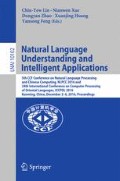Abstract
Terms extensively exist in specific domains, and term translation plays a critical role in domain-specific statistical machine translation (SMT) tasks. However, it’s a challenging task to extract term translation knowledge from parallel sentences because of the error propagation in the SMT training pipeline. In this paper, we propose a simple, straightforward and effective model to mitigate the error propagation and improve the quality of term translation. The proposed model goes from initial weak monolingual detection of terms based on naturally annotated resources (e.g. Wikipedia) to a stronger bilingual joint detection of terms, and allows the word alignment to interact. The extensive experiments show that our method substantially boosts the performance of bilingual term detection by more than 8 points absolute F-score. And the term translation quality is substantially improved by more than 3.66% accuracy, as well as the sentence translation quality is significantly improved by 0.38 absolute BLEU points, compared with the strong baseline, i.e. the well tuned Moses.
Access this chapter
Tax calculation will be finalised at checkout
Purchases are for personal use only
Notes
- 1.
In this paper, we do not consider named entities (e.g., person names, location names, organization names, time and numbers) and treat named entities non-terms.
References
Ananiadou, S.: A methodology for automatic term recognition. In: Proceedings of COLING 1994 (1994)
Chen, Y., Zong, C., Su, K.Y.: A joint model to identify and align bilingual named entities. Comput. Linguist. 39(2), 1–64 (2012)
Chieu, H.L., Ng, H.T.: Named entity recognition: a maximum entropy approach using global information. In: Proceedings of the 19th International Conference on Computational Linguistics (2002)
Daille, B.: Study and implementation of combined techniques for automatic extraction of terminology. Balanc. Act: Comb. Symb. Stat. Approaches Lang. 1, 49–66 (2002)
Darroch, J.N., Ratcliff, D.: Generalized iterative scaling for log-linear models. Ann. Math. Stat. 43(5), 1470–1480 (1972)
Fahmi, B.I., Bouma, G., Plas, L.V.D.: Improving statistical method using known terms for automatic term extraction. In: Computational Linguistics in the Netherlands-CLIN 2007 (2007)
Fan, X., Shimizu, N., Nakagawa, H.: Automatic extraction of bilingual terms from a Chinese-Japanese parallel corpus. In: International Universal Communication Symposium 2009 (2009)
Forney, G.D.: The viterbi algorithm. Proc. IEEE 61(3), 268–278 (1973)
Frantzi, K., Ananiadou, S., Mima, H.: Automatic recognition of multi-word terms: the c-value/nc-value method. Int. J. Digit. Libr. 3(2), 115–130 (2000)
Fraser, A., Marcu, D.: Measuring word alignment quality for statistical machine translation. Fraser Alexander Daniel Marcu 33(3), 293–303 (2007)
Kageura, K., Umino, B.: Methods of automatic term recognition: a review. Terminology 3(2), 259–289 (1996)
Koehn, P.: Statistical significance tests for machine translation evaluation. In: Proceedings of the EMNLP 2004 (2004)
Koehn, P., Hoang, H., Birch, A., Callison-Burch, C., Federico, M., Bertoldi, N., Cowan, B., Shen, W., Moran, C., Zens, R.: Moses: open source toolkit for statistical machine translation. In: Proceedings of ACL 2007 (2007)
Kostoff, R.N., Block, J.A., Solka, J.L., Briggs, M.B., Rushenberg, R.L., Stump, J.A., Johnson, D., Lyons, T.J., Wyatt, J.R.: Literature-related discovery. Ann. Rev. Inf. Sci. Technol. 43(1), 171 (2009)
Krauthammer, M., Nenadic, G.: Term identification in the biomedical literature. J. Biomed. Inform. 37(6), 512–526 (2004)
Kupiec, J.: An algorithm for finding noun phrase correspondences in bilingual corpora. In: Proceedings of ACL 1993 (1993)
Lefever, E., Macken, L., Hoste, V.: Language-independent bilingual terminology extraction from a multilingual parallel corpus. In: Proceedings of EACL 2009 (2009)
Liu, Y., Liu, Q., Lin, S.: Discriminative word alignment by linear modeling. Comput. Linguist. 36(3), 303–339 (2010)
Manning, C., Dan, K.: Optimization, maxent models, and conditional estimation without magic. In: Proceedings of the NAACL 2003 (2003)
Medelyan, O., Witten, I.H.: Thesaurus based automatic keyphrase indexing. In: Proceedings of the ACM/IEEE-CS Joint Conference on Digital Libraries (2006)
Nakagawa, H., Mori, T.: Nested collocation and noun for term extraction. In: Proceedings of the First Workshop on Comutational Terminology (COMPUTERM 1998) (1998)
Och, F.J., Ney, H.: Discriminative training and maximum entropy models for statistical machine translation. In: Proceedings of ACL 2002 (2002)
Och, F.J., Ney, H.: A systematic comparison of various statistical alignment models. Comput. Linguist. 29(1), 19–51 (2003)
Papineni, K., Roukos, S., Ward, T., Zhu, W.: BLEU: a method for automatic evaluation of machine translation. In: Proceedings of the ACL 2002 (2002)
Sager, J.C., Dungworth, D., McDonald, P.F.: English Special Languages: Principles and Practice in Science and Technology. John Benjamins Publishing Company, Amsterdam (1980)
Vogel, S., Ney, H., Tillmann, C.: HMM-based word alignment in statistical translation. In: Proceedings of the 16th Conference on Computational Linguistics, vol. 2, pp. 836–841 (1996)
Wang, M., Che, W., Manning, C.D.: Joint word alignment and bilingual named entity recognition using dual decomposition. In: Proceedings of ACL 2013 (2013)
Xiong, D., Liu, Q., Lin, S.: Maximum entropy based phrase reordering model for statistical machine translation. In: proceedings of COLING-ACL 2006 (2006)
Zaidan, O.F.: Z-MERT: a fully configurable open source tool for minimum error rate training of machine translation systems. Prague Bull. Math. Linguist. 91, 79–88 (2009)
Zhang, Z., Iria, J., Brewster, C.: A comparative evaluation of term recognition algorithms. In: LREC 2008 (2008)
Acknowledgments
The research work has been funded by the Natural Science Foundation of China under Grant No. 61403379.
Author information
Authors and Affiliations
Corresponding author
Editor information
Editors and Affiliations
Rights and permissions
Copyright information
© 2016 Springer International Publishing AG
About this paper
Cite this paper
Huang, G., Zhang, J., Zhou, Y., Zong, C. (2016). A Simple, Straightforward and Effective Model for Joint Bilingual Terms Detection and Word Alignment in SMT. In: Lin, CY., Xue, N., Zhao, D., Huang, X., Feng, Y. (eds) Natural Language Understanding and Intelligent Applications. ICCPOL NLPCC 2016 2016. Lecture Notes in Computer Science(), vol 10102. Springer, Cham. https://doi.org/10.1007/978-3-319-50496-4_9
Download citation
DOI: https://doi.org/10.1007/978-3-319-50496-4_9
Published:
Publisher Name: Springer, Cham
Print ISBN: 978-3-319-50495-7
Online ISBN: 978-3-319-50496-4
eBook Packages: Computer ScienceComputer Science (R0)

